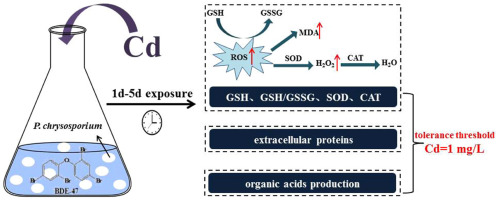Ecotoxicology and Environmental Safety ( IF 6.8 ) Pub Date : 2018-02-22 , DOI: 10.1016/j.ecoenv.2018.02.018 Mi Feng , Hua Yin , Yajuan Cao , Hui Peng , Guining Lu , Zehua Liu , Zhi Dang

|
Cd-induced stress response of Phanerochaete chrysosporium during the biodegradation of BDE-47 was investigated in this study, with the goal of elucidating the tolerance behavior and the detoxification mechanisms of P. chrysosporium to resist the Cd stress in the course of BDE-47 biodegradation, which has implications for expanding the application of P. chrysosporium in the bioremediation of Cd and BDE-47 combined pollution. The results suggested that single BDE-47 exposure did not induce obvious oxidative stress in P. chrysosporium, but coexistent Cd significantly triggered ROS generation, both intracellular ROS level and H2O2 content showed positive correlation with Cd concentration. The activities of SOD and CAT were enhanced by low level of Cd (≤ 1 mg/L), but Cd of higher doses (>1 mg/L) depressed the expression of these two antioxidant enzymes at the later exposure period (3–5 days). The intracellular content of GSH along with GSH/GSSG ratio also exhibited a bell-shaped response with a maximum value at Cd of 1 mg/L. Furthermore, Cd-induced ROS generation resulted in the lipid peroxidation, as indicated by a noticeable increment of MDA content found after 3 days. Moreover, the study also indicated that Cd less than 1 mg/L promoted the production of extracellular protein and quickened the decrease of pH value in the medium, while excessive Cd (>1 mg/L) would lead to inhibition. These findings obtained demonstrated that P. chrysosporium had a certain degree of tolerance to Cd within a specific concentration range via regulating the antioxidant levels, inducing the synthesis of extracellular protein as well as stimulating the production of organic acids, and 1 mg/L is suggested to be the tolerance threshold of this strains under Cd stress during BDE-47 biodegradation.
中文翻译:

镉引起的Phanerochaete chrysosporium在2,2',4,4'-四溴二苯醚(BDE-47)生物降解过程中的应力响应
本研究以BDE-47生物降解过程中Cd诱导的Phanerochaete chrysosporium的胁迫响应为研究对象,以阐明P. chrysosporium对BDE-47生物降解过程中的抗Cd胁迫的耐受行为和解毒机理。,这对于扩大金孢假单胞菌在Cd和BDE-47复合污染的生物修复中的应用具有重要意义。结果表明,单次接触BDE-47不会在金黄色葡萄球菌中引起明显的氧化应激,但共存的Cd会显着触发ROS的产生,包括细胞内ROS水平和H 2 O 2。含量与镉浓度呈正相关。低水平的Cd(≤1 mg / L)增强了SOD和CAT的活性,但是较高剂量的Cd(> 1 mg / L)则在暴露后期(3-5)抑制了这两种抗氧化酶的表达。天)。GSH的细胞内含量以及GSH / GSSG比也显示出钟形响应,在Cd处的最大值为1 mg / L。此外,Cd诱导的ROS生成导致脂质过氧化,如3天后发现的MDA含量明显增加所表明的。此外,研究还表明,低于1 mg / L的Cd会促进细胞外蛋白质的产生,并加快培养基中pH值的降低,而过量的Cd(> 1 mg / L)会导致抑制作用。获得的这些发现证明金黄色葡萄球菌 通过调节抗氧化剂水平,诱导细胞外蛋白的合成以及刺激有机酸的产生,在特定浓度范围内对镉具有一定程度的耐受性,因此建议该菌株的耐受阈值为1 mg / L在BDE-47生物降解过程中受到Cd胁迫。



























 京公网安备 11010802027423号
京公网安备 11010802027423号